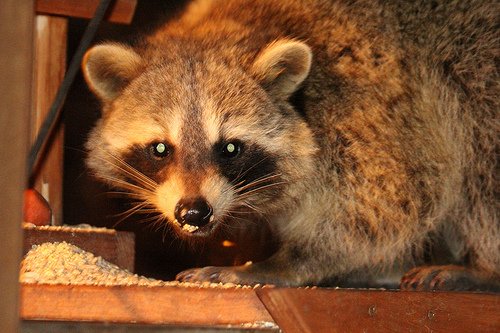How Are Raccoons Getting Into Your Attic?

Raccoons and other wild animals seek out warm, safe, and dry places to live and raise their young. They frequently seek refuge inside people’s homes, particularly attics. If you’re hearing noises in the attic at night, you likely have a raccoon problem.
Many homeowners have no idea how the raccoons got into the attic. Raccoons have excellent climbing skills. They sometimes use a nearby tree with a long branch that hangs over the house to climb onto a roof. Raccoons can also climb up a downspout or the corner of a house.
Raccoons can scratch and chew their way into an attic once they’ve climbed onto a roof. They may chew and scratch at a small gap in a soffit or under an eave until they create a space large enough to crawl through and gain access to the attic.
Learn More: Frequently Asked Raccoon Damage Repair Questions
How Can Raccoons Enter Attics Through Roof Vent?
When it comes to creating a den inside your home, raccoons are incredibly resourceful. Raccoons frequently gain access to attics and crawl spaces through open ventilation holes in the roof. To gain access to an attic, they have been known to pull away metal flashing that protects the vents.
Any uncovered ventilation hole is an opportunity for a raccoon, but raccoons will also tear their way into screened vents if there is any kind of gap.
Why Is The Edge Of A Roof Torn Open By Raccoons?
The area where the eavestrough meets the house on the edge of your roof is particularly vulnerable to raccoon intrusion. Melted snow and rain on the roof must pass through this section on their way to the eavestrough by design. This roof area deteriorates faster than any other due to high moisture levels and constant freezing or thawing. To gain access to the attic, opportunistic raccoons easily chew and tear away the rotted wood.
Why Are Chimneys An Easy Entry Point For Raccoons?
The raccoon is the most common animal found in chimneys. Mother raccoons will usually enter a chimney to give birth to their young and then raise them. Because chimneys are similar to hollow trees, which are a favorite nesting spot for male raccoons, they provide sufficient protection to build a nest. Raccoons are excellent climbers, so if you don’t have a chimney cap in place, they’ll have no trouble getting in and out.
How Do Raccoons Enter Attics Through Soffits?
In chimneys and attics, raccoons like to build dens. For a variety of reasons, soffits are convenient entry points:
- Because soffits are not exposed to the elements, their construction is often simple, consisting of a thin aluminum or vinyl panel that a raccoon can easily pry open.
- Your soffit will usually be located near a roof corner and will have a simple, lightweight covering.
- Raccoons can feel the warm, dry air through vents in soffits and think it’s a perfect place to build a nest.
How To Remove A Raccoon From The Attic?
Something to think about when a raccoon invades your attic is safety. A cornered animal will feel threatened and may attack. Also, the droppings it leaves behind can carry diseases that may infect any person that comes into contact with it. Repellent products are often ineffective and end up agitating the animals. Contacting a wildlife removal expert is the best way to protect the people living in the infested home.
Raccoon trapping is the most effective raccoon removal method, but trapping raccoons is illegal in most states, so it’s best to hire a professional who specializes in raccoon control. Troublesome raccoons, as well as any baby raccoons that may be present, can be safely trapped and relocated in the wild, a safe distance from the house. Wildlife professionals provided by Animals Happen will also assist you in repairing the entry points to keep raccoons out of your attic.
